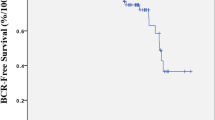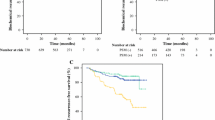Abstract
Purpose
Our aim was to identify prognostic factors and examine the usefulness of postoperative nadir prostate-specific antigen (PSA) value obtained by ultrasensitive assay for prediction of PSA relapse in prostate cancer patients with pathological T3 (pT3) or positive surgical margins.
Methods
We analyzed 102 patients who were pathological T2 with positive surgical margins or pT3 without pathological lymph node metastasis or neoadjuvant hormonal therapy. Patients were classified into three groups according to postoperative nadir PSA value: <0.01 ng/ml, ≥0.01 ng/ml but <0.02 ng/ml, and ≥0.02 but <0.10 ng/ml. PSA relapse-free rate was compared according to postoperative nadir PSA. Univariate and multivariate analyses with the Cox proportional hazards regression model identified prognostic factors for PSA relapse.
Results
Of the 102 patients, 22 (21.6%) developed PSA relapse within a median follow-up time of 31.3 months. PSA relapse-free rate at 30 months was 81.2%. Univariate and multivariate analyses revealed that postoperative nadir PSA was the only statistically significant risk factor: postoperative nadir PSA ≥0.01 ng/ml but <0.02 ng/ml (P = 0.009, HR: 4.502, 95% CI: 1.457–13.916); ≥0.02 ng/ml but <0.10 ng/ml (P < 0.001, HR: 15.126, 95% CI: 4.738–48.292). PSA relapse-free rates at 30 months in patients with postoperative nadir PSA <0.01 ng/ml, ≥0.01 ng/ml but <0.02 ng/ml, and ≥0.02 ng/ml but <0.10 ng/ml were 91.9, 57.1, and 20.0%, respectively.
Conclusions
Postoperative nadir PSA value obtained by ultrasensitive assay was useful as a predictor of PSA relapse among patients with adverse pathological features. Patients with postoperative nadir PSA of <0.01 ng/ml may have low risk of PSA relapse.



Similar content being viewed by others
References
Bolla M, van Poppel H, Collette L, van Cangh P, Vekemans K, Da Pozzo L, de Reijke TM, Verbaeys A, Bosset JF, van Velthoven R, Maréchal JM, Scalliet P, Haustermans K, Piérart M; European Organization for Research and Treatment of Cancer (2005) Postoperative radiotherapy after radical prostatectomy: a randomised controlled trial (EORTC trial 22911). Lancet 366:572–578
Wiegel T, Bottke D, Steiner U, Siegmann A, Golz R, Störkel S, Willich N, Semjonow A, Souchon R, Stöckle M, Rübe C, Weissbach L, Althaus P, Rebmann U, Kälble T, Feldmann HJ, Wirth M, Hinke A, Hinkelbein W, Miller K (2009) Phase III postoperative adjuvant radiotherapy after radical prostatectomy compared with radical prostatectomy alone in pT3 prostate cancer with postoperative undetectable prostate-specific antigen: ARO 96–02/AUO AP 09/95. J Clin Oncol 27:2924–2930
Shen S, Lepor H, Yaffee R, Taneja SS (2005) Ultrasensitive serum prostate specific antigen nadir accurately predicts the risk of early relapse after radical prostatectomy. J Urol 173:777–780
Doherty AP, Bower M, Smith GL, Miano R, Mannion EM, Mitchell H, Christmas TJ (2000) Undetectable ultrasensitive PSA after radical prostatectomy for prostate cancer predicts relapse-free survival. Br J Cancer 83:1432–1436
Eisenberg ML, Davies BJ, Cooperberg MR, Cowan JE, Carroll PR (2010) Prognostic implications of an undetectable ultrasensitive prostate-specific antigen level after radical prostatectomy. Eur Urol 57:622–629
Inagaki T, Kohjimoto Y, Nishizawa S, Kuramoto T, Nanpo Y, Fujii R, Matsumura N, Shintani Y, Uekado Y, Hara I (2009) PSA at postoperative three months can predict biochemical recurrence in patients with pathological T3 prostate cancer following radical prostatectomy. Int J Urol 16:941–946
American Joint Committee on Cancer (2002) AJCC cancer staging manual, 6th edn. Springer, New York
Cookson MS, Aus G, Burnett AL, Canby-Hagino ED, D’Amico AV, Dmochowski RR, Eton DT, Forman JD, Goldenberg SL, Hernandez J, Higano CS, Kraus SR, Moul JW, Tangen C, Thrasher JB, Thompson I (2007) Variation in the definition of biochemical recurrence in patients treated for localized prostate cancer: the American urological association prostate guidelines for localized prostate cancer update panel report and recommendations for a standard in the reporting of surgical outcomes. J Urol 177:540–545
Vis AN, Schröder FH, van der Kwast TH (2006) The actual value of the surgical margin status as a predictor of disease progression in men with early prostate cancer. Eur Urol 50:258–265
Swanson GP, Riggs M, Hermans M (2007) Pathologic findings at radical prostatectomy: risk factors for failure and death. Urol Oncol 25:110–114
Amling CL, Blute ML, Bergstralh EJ, Seay TM, Slezak J, Zincke H (2000) Long-term hazard of progression after radical prostatectomy for clinically localized prostate cancer: continued risk of biochemical failure after 5 years. J Urol 164:101–105
Wright JL, Dalkin BL, True LD, Ellis WJ, Stanford JL, Lange PH, Lin DW (2010) Positive surgical margins at radical prostatectomy predict prostate cancer specific mortality. J Urol 183:2213–2218
Thompson IM, Tangen CM, Paradelo J, Lucia MS, Miller G, Troyer D, Messing E, Forman J, Chin J, Swanson G, Canby-Hagino E, Crawford ED (2009) Adjuvant radiotherapy for pathological T3N0M0 prostate cancer significantly reduces risk of metastases and improves survival: long-term followup of a randomized clinical trial. J Urol 181:956–962
Feng M, Hanlon AL, Pisansky TM, Kuban D, Catton CN, Michalski JM, Zelefsky MJ, Kupelian PA, Pollack A, Kestin LL, Valicenti RK, DeWeese TL, Sandler HM (2007) Predictive factors for late genitourinary and gastrointestinal toxicity in patients with prostate cancer treated with adjuvant or salvage radiotherapy. Int J Radiat Oncol Biol Phys 68:1417–1423
Swindle P, Eastham JA, Ohori M, Kattan MW, Wheeler T, Maru N, Slawin K, Scardino PT (2005) Do margins matter? The prognostic significance of positive surgical margins in radical prostatectomy specimens. J Urol 174:903–907
Ekici S, Ayhan A, Erkan I, Bakkaloğlu M, Ozen H (2003) The role of the pathologist in the evaluation of radical prostatectomy specimens. Scand J Urol Nephrol 37:387–391
Amling CL, Bergstralh EJ, Blute ML, Slezak JM, Zincke H (2001) Defining prostate specific antigen progression after radical prostatectomy: what is the most appropriate cut point? J Urol 165:1146–1151
Ward JF, Blute ML, Slezak J, Bergstralh EJ, Zincke H (2003) The long-term clinical impact of biochemical recurrence of prostate cancer 5 or more years after radical prostatectomy. J Urol 170:1872–1876
Thompson IM Jr, Tangen CM, Paradelo J, Lucia MS, Miller G, Troyer D, Messing E, Forman J, Chin J, Swanson G, Canby-Hagino E, Crawford ED (2006) Adjuvant radiotherapy for pathologically advanced prostate cancer: a randomized clinical trial. JAMA 296:2329–2335
Author information
Authors and Affiliations
Corresponding author
Rights and permissions
About this article
Cite this article
Yoshida, T., Matsuzaki, K., Kobayashi, Y. et al. Usefulness of postoperative nadir prostate-specific antigen value by ultrasensitive assay as a predictor of prostate-specific antigen relapse for pathological T3 or positive surgical margins after radical prostatectomy for prostate cancer. Int Urol Nephrol 44, 479–485 (2012). https://doi.org/10.1007/s11255-011-0044-5
Received:
Accepted:
Published:
Issue Date:
DOI: https://doi.org/10.1007/s11255-011-0044-5




